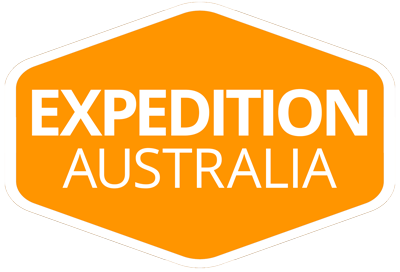If you're looking for tips and tricks to cut costs and drive around Australia on a budget then this article is for you.
One of the biggest hurdles when it comes to planning your Big Lap around Australia has always been the cost.
But now soaring fuel prices and inflation are making everything even more expensive than ever before so it's never been more important to find clever ways to save money.
The good news is that there are many ways to reduce your costs so that you can drive around Australia on a tight budget.
Before we get down to more detail on how to drive around Australia on a budget, make sure you have a copy of our free Big Lap Budget Spreadsheet.
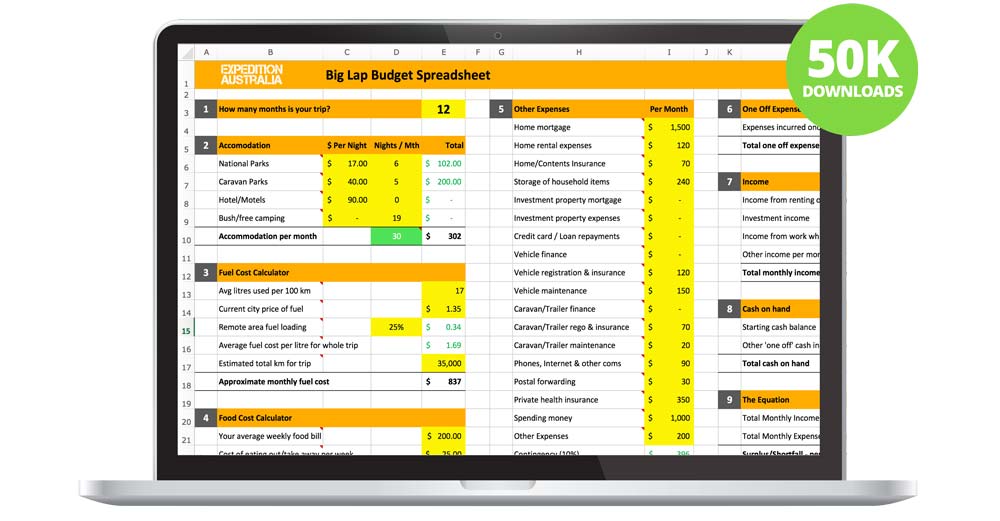
Download the Big Lap Budget Spreadsheet
I created the Big Lap Budget Spreadsheet to help you work out how much money you'll need for your Big Lap, taking into account the expenses and income that are relevant to YOU.
Some people will tell you to budget $1.00 per kilometre or $1000 per week and that might work for them, but not necessarily for you.
You'll also see other big lappers sharing their monthly expenses breakdowns which can be useful but once again, the same numbers probably won't apply to you.
You can get a much better estimate of how much money you'll need by downloading the Big Lap Budget Spreadsheet and working it out for yourself.
Once you have your Big Lap Budget Spreadsheet and you've entered your numbers you may be seeing a negative bottom line.
This is basically saying that you need to find ways to either increase your income and cash reserves or reduce your costs.
Probably a combination of both.
To find ways to earn money while travelling around Australia you can check out this post . . .
Read More > 23 Ways To Earn Money Travelling Around Australia
But for now, let's look at ways you can cut your costs so you CAN drive around Australia on a budget.
On your Big Lap there are three main areas where you will most likely spend most of your money:
- Fuel
- Accomodation
- Food
These are the three ‘Big Ones’ and the areas you want to focus on slashing your costs if your goal is to drive around Australia on a budget.
Other expenses like tours can also add up to a lot of money but unlike food, fuel and accomodation which are essential, tours are optional so at your discretion.
So with that in mind . . . let’s get started . . .
Cash Is King - Use Cash Instead of Plastic Cards
It seems that we are rapidly marching down the path of becoming a cashless society, especially with innovations like PayWave and Apple Pay making it so easy to pay for things just by waving your card or phone over a sensor.
The trouble is that we’ve lost the sense of spending actual money and there is no doubt that counting actual cash out of your wallet or purse ‘feels’ like more money than waving a card over a scanner.
Sure the banks will tell you about frequent flyer points using your credit card but my recommendation is that if you are travelling on a tight budget, you basically forget about accumulating frequent flyers and use cash as much as possible.
When you are spending cash it is real money and you’ll be more careful about parting with it.
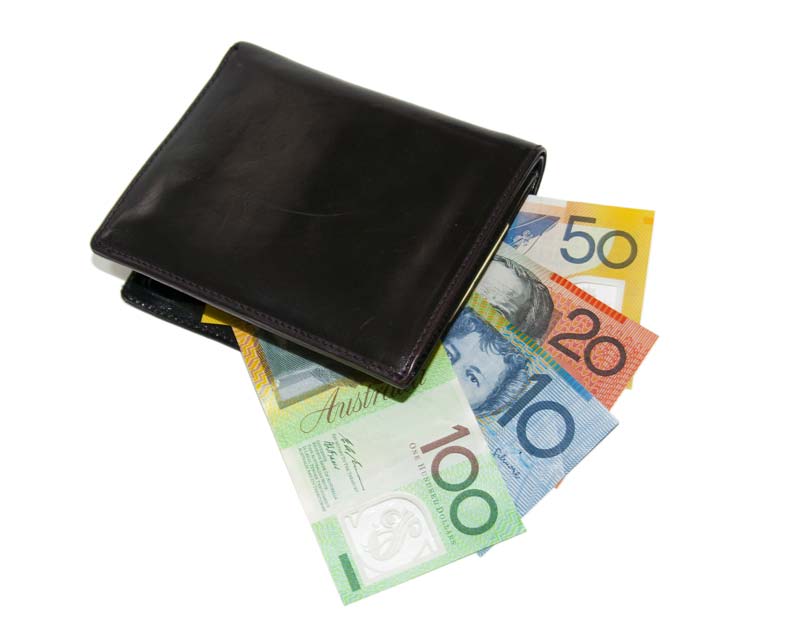
On our Big Lap we were travelling on a tight budget and needed to stretch our savings to last the full 16 months of our trip.
We used a plastic card and dedicated bank account for fuel but for everyday expenses we used cash.
We set ourselves a weekly budget for spending money, food and accommodation and made envelopes for each one.
Each week or two we’d take enough money out of the bank (ATM usually) and would put the budgeted amount in each envelope and make it last however long it needed to until the next withdrawal - this forced us to stick to our budget.
If one envelope came up short then we'd take it from another envelope, not the bank.
We hid the envelopes in with our gear so we could access them easily but we weren’t carrying them around with us day to day.
This system worked well and most weeks we would end up not spending all the cash in the envelopes so we'd have a bit extra accumulating that we could spend later on.
It was only in the last couple of months when the cash reserves were running low that we started to use our credit cards but there is no doubt that by having a ‘cash’ mindset for the bulk of the trip we stretched our budget a lot further.
One of the best things about travelling around Australia is getting back to basics and getting back to cash is a valuable part of that.
Spend Less On Your vehicle and Van/Trailer
You DON'T need a flashy new 4WD and Caravan!
Before you even start your Big Lap you'll probably be spending money on a lot of gear to get yourself setup for the trip.
Any money you can save getting setup might help to fund the trip once you get going so the good news is that you don't need to blow your budget before you've even left the driveway.
A brand new 4WD and caravan or camper trailer could easily set you back over $200,000 these days but if your goal is to drive around Australia on a budget then you can definitely get away with something much simpler and cheaper.
Second hand vehicle prices have jumped along with everything else due to Covid, and this is mainly due to the long delays in taking delivery of a new vehicle.
Currently the wait for a new Toyota Troopcarrier is 24 months . . . no wonder the price of second hand ones is so high!
Caravans and camper trailers are in a similar situation with a spike in demand and reduced production capacity causing very long lead times.
But despite all of this you can still buy a relatively modern and very capable vehicle for well under $40,000.
Like this Toyota Hilux for example:
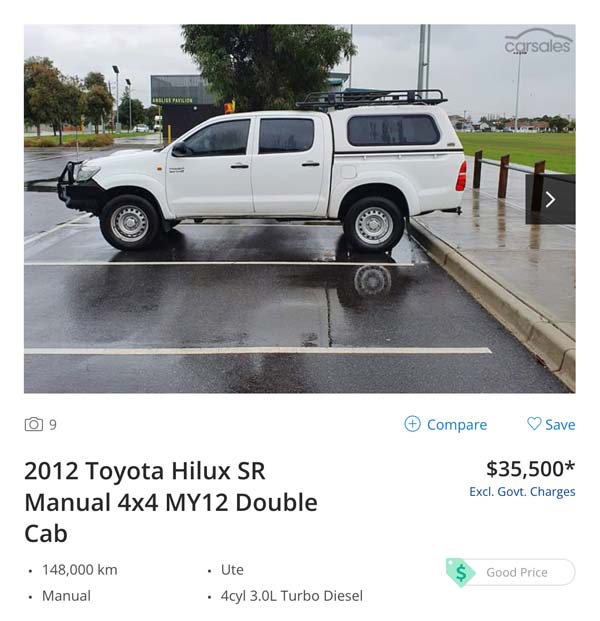
A vehicle like this will get you everywhere you need to go comfortably and reliably and easily tow a van or trailer.
This particular 4WD already has a bullbar, canopy and roof rack so you've saved about $5000 already by not having to buy those.
Plus being a 4 cyclinder turbo diesel it will be very economical to run.
When you've finished your Big Lap, if you want to sell the 4WD you'll most likely get almost all of your money back so overall you won't be too much out of pocket. (Sell your used car using Grays)
As for caravans and camper trailers, there are still plenty of affordable good second hand options available like this one below for well under $20,000.
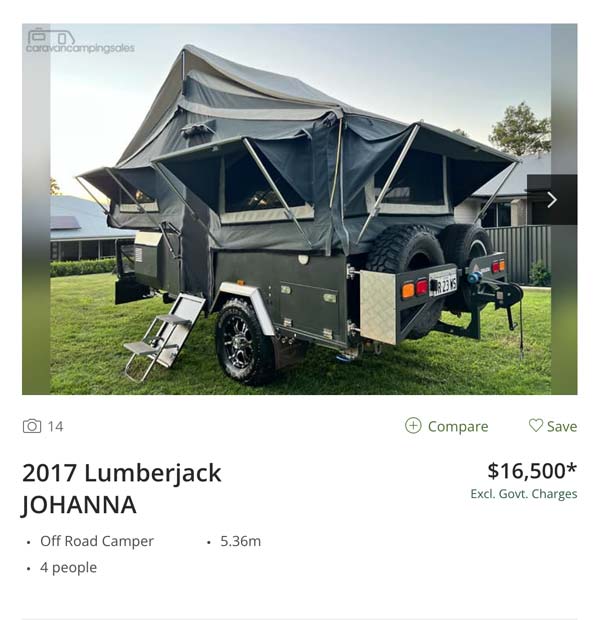
So for around $50,000 you have a very capable and reliable vehicle with an off-road camper trailer and a rig that will take you down virtually any road or track in Australia.
Plus being lightweight and streamlined you'll be saving on fuel as well.
This is of course just an example and you could go even cheaper if you need to.
Buy a mid sized turbo diesel vehicle
You’ll potentially drive more than 35,000 km on your Big Lap around Australia and if you do that in 12 months then it’s about double what the average car does in a year.
With fuel costing up to 200% of the city price in remoter regions, taking steps to minimise fuel consumption can make a significant difference to your budget.
In general, diesel engine vehicles get much better mileage than petrol powered equivalents and this mileage also remains fairly consistent when the vehicle is loaded up and towing.
Maybe increasing by only 10% - 15%.
By comparison the fuel usage on a petrol powered vehicle can increase substantially when they are loaded up . . . which yours will be.
Fortunately for us, diesel powered four wheel drives are very popular in Australia and finding a good one is not difficult.
A turbo diesel will generally not use any more fuel than a non-turbo but will deliver much better performance, especially at higher revs, so if you are going diesel, look for a turbo if you can.
This won't be hard because virtually all modern diesel engines have a turbo.
Our turbo diesel 80 Series Landcruiser with 4.2 litre 6 cylinder engine averaged around 17 ltr/100km on our Big Lap. That’s fully loaded with gear, 4 people and towing a camper trailer across every type of road surface.
The normal unladen city cycle is about 14 ltr/100km so not much difference there.
By comparison, a petrol version of the same vehicle would more likely use around 25 litres per 100km, a potential difference of several thousand litres of fuel over the whole trip.
That’s real money.
But these days we can do even better than the relatively inefficient turbo diesel 80 Series.
Modern 4 cylinder turbo diesel 4WD's like the Hilux, Ranger, Triton, D-Max and Navara are substantially more economical than an older and larger models like the 80 Series Landcruiser.
You'd expect these vehicles to use around 10 to 12 litres per 100km which would add up to more than $5000 less money spent on fuel on your Big Lap compared with a larger vehicle using 17 litres per 100km.
Diesel vehicles cost more than their petrol equivalent to buy but are also hold their market value and are worth more when you eventually sell.
Diesel is used everywhere by farmers and mining companies so it will always be available in an emergency and there are no restrictions in some remote communities which may not sell unleaded petrol.
It’s also less volatile than petrol and safer to transport.
Maximise fuel capacity
In almost every area of your rig setup I recommend choosing a lightweight option - I'll cover this in more detail further on.
However the one area I suggest carrying more weight, is fuel.
Reducing overall weight by carrying less fuel is false economy.
Fuel prices vary significantly from one place to the next and having the option to bypass more expensive fuels stops for a lower cost one further down the track can save you a lot of money.
Having the option to carry an extra 100 or more litres on board when you need to gives you the flexibility to choose where, when and how much fuel you buy.
For example:
The price of diesel right now (10/6/2022) at Yulara (Uluru) is $2.72 per litre. But the price of diesel at Alice Springs is as low as $2.17 per litre - a difference of $0.55 per litre.
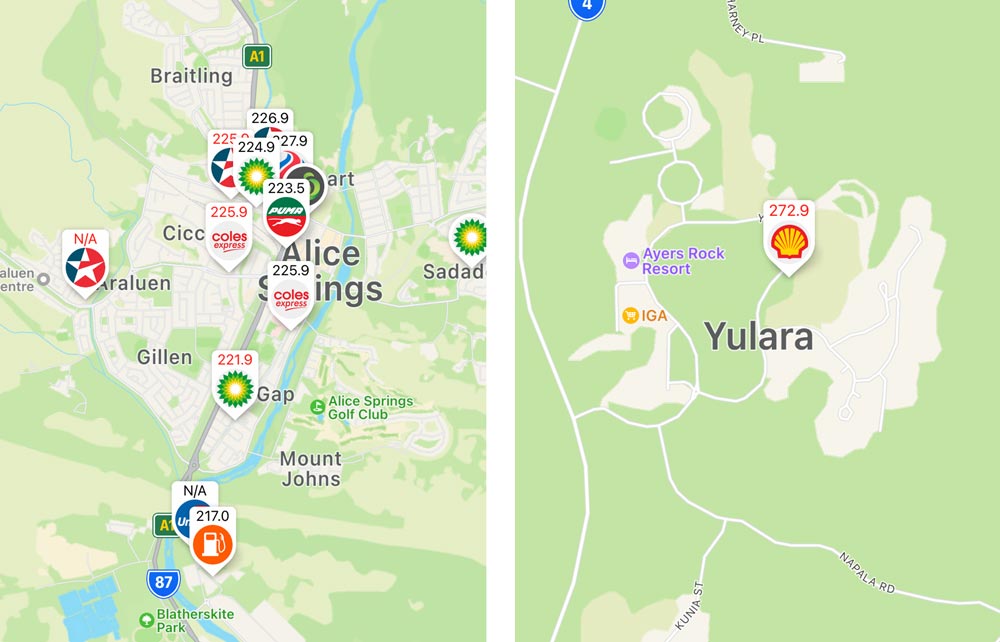
The distance between Alice Springs and Yulara is around 450km so with a vehicle that uses 12 ltr per 100km you can save about $30 on fuel by having enough on board when you leave Alice Springs to get you to Yulara and back to Alice Springs.
(450km x 12ltr/100km x $0.55 = $29.70)
Now $29.70 is not a fortune but there will be many times on your Big Lap where this will apply and over time it will add up to hundreds and potentially even a couple thousand dollars in savings.
The best way to carry extra fuel is with a long range tank like the Long Ranger but it isn't essential.

3 x 20 ltr jerry cans like these will cost you around $100 total and you can just fill them up as and when you need to.

I have an article which talks more about options for carrying fuel and whether or not you need a long range fuel tank which you can read here > Do you need a long range fuel tank?
Plan Your Fuel Purchases With the FuelMap App
Following on from the previous idea of being able to carry more fuel, is the ability to be able to know what the fuel price is at the places you're planning to visit down the track.
An app called FuelMap solves this problem.

You can find it in the app store on your phone or tablet.
The app uses crowd sourced information to show users the recent fuel price at most of the fuel stations around Australia.
Users can update the fuel price at any time so in most cases the data is very recent - today, yesterday or the past few days.
While prices do fluctuate, the app will give you a pretty good idea of the prices you'll be paying in the towns you're heading to and can also highlight the fuel suppliers in the area that are on the lower end of the price scale.
You can see a great example in the screen shot below.
The price of fuel at Shell Warumungu (Three Ways) is 249.9 but down the road in Tennant Creek it's 215.9.
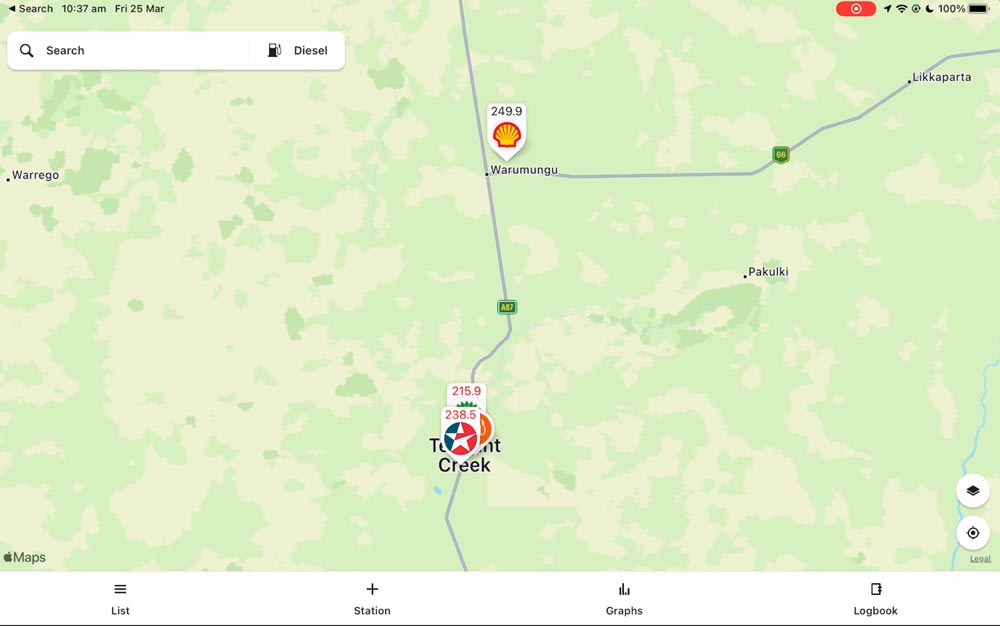
Definitely worth the detour south if you're planning a big fill up.
Purchasing 200 litres of fuel would be $68 less at the United in Tennant Creek.
Travel Light
Having started our Big Lap carrying way too much gear I’m much more of an advocate of travelling as light as you possibly can these days.
There is a temptation to include all of the shiny gadgets and spares for everything but the reality is that ‘less is more’.
I wrote an article called ‘The 80% Packing Rule’ which you might find useful.
Besides having to manage all the gear, your vehicle needs to carry it all the way around the country and the more it weighs the more fuel you’ll burn getting it there.
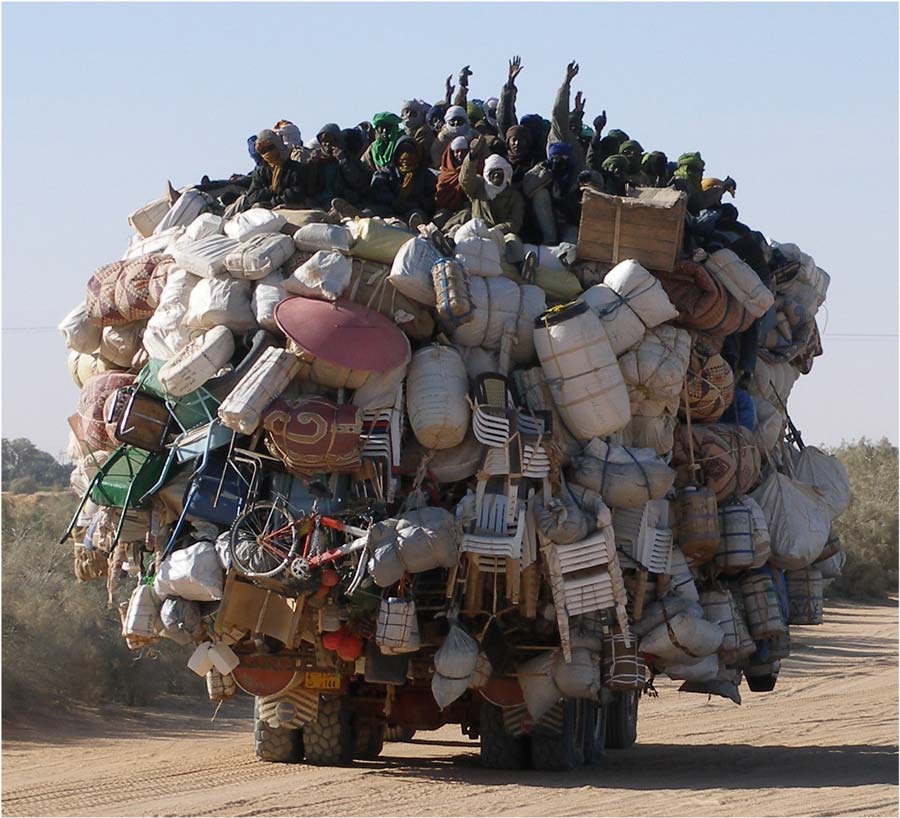
An off-road camper trailer might weigh around 1500kg fully loaded compared with a caravan which can be more than 3000kg.
I's not just the extra weight you're dragging around but also the extra wind resistance.
Also the police are a lot more conscious of overweight vehicles and vans these days compared with even just 10 years ago.
So not only will you burn more fuel carrying more weight but if you're over the vehicles GVM (Gross Vehicle Mass) or GCM (Gross Combined Mass) for the vehicle and van then you risk being defected by the law.
I’ve always loved bushwalking and the older I get the more conscious I am about getting my gear to the lightest it can be.
In fact it has become a major topic of discussion on most hiking trips these days and there is a definite competitive element to see who can arrive on day one with the lightest pack.
When you have to carry everything yourself, every gram counts and the same goes for your vehicle.
While a kilogram here and there is no big deal, hundreds or even thousands of kilograms make a big difference.
So when planning your rig setup and what you are going to take and what you are going to leave behind, keep the weight of everything high up on your list of considerations.
And live by the mantra . . . Less is more!
Our Road Trip Packing List & Weight Calculator has over 500 items to consider including in your kit (you won't need everything) plus a built in weight calculator so you can keep an eye on the weight of your rig as you're getting everything together.

Manage Your Tyre Pressures
Having your tyres correctly inflated is critical for safety and tyre performance.
But it also affects fuel economy.
This is why you absolutely must include a compressor in your kit so you can maintain your tyres at the right pressure all of the time.
This is a good compressor > Bushranger Max Air 3 Air Compressor
When you’re travelling in remote areas it’s not unusual to cover long stretches of unsealed road or tracks and you will need to lower your tyre pressures to gain more traction, smooth the ride and reduce the wear on your tyres.
But when you get back to the sealed road you don’t want to be driving on tyres that are under inflated.
The tyres will run hotter and wear faster and be more prone to a blowout, plus the additional drag will reduce your fuel economy.
The 10 minutes it takes to re-inflate your tyres for the sealed road is well invested and a good opportunity for a break anyway.
So managing tyre pressures will make your tyres last longer which saves you money AND optimise your fuel economy while you’re at it.
Don’t forget to adjust the tyres on your trailer or caravan as well.
As for ‘What is the correct pressure?’ . . . it depends on the type of tyres, the weight of your rig and the road surface.
Check out this article for more details about tyre pressures > What Tyre Pressures Do I Run On Road Trips?
Be Self sufficient and use free or low cost camps
The second of our 'Big 3' expenses is accomodation - the fees you will pay to stay in caravan parks and other paid camping sites.
In recent years the price of caravan parks has increased considerably along with the increasing quality of the service and facility that a lot of them provide.
It's not unusual to see overnight stays on a powered site as high as $70 - $100 and even higher in peak times.
At these prices you can easily spend over $20,000 in a year staying in caravan parks.
This has created the opportunity to save a lot of money and help you to drive around Australia on a budget by being more self sufficient and able to stay in free or low cost camps.
There are thousands of free and low cost camp sites around Australia but the compromise is that you most likely won't have power, water on tap and reliable toilet facilities.
However these are easy problems to overcome by setting up your rig (vehicle + van/trailer) to be self sufficient.
This involves having solar panels (or a generator), built in batteries to store power, water tanks, shower and a toilet facility of some kind as well as your own kitchen . . . which you're likely to have anyway.
Many modern caravans have built in bathrooms but even without that, you can buy a pop up tent, a Porta Potti and solar shower for a few hundred dollars and you have a good basic setup.



If you can build a couple of water tanks into your rig that is ideal but if not, then storing water in jerry cans is easy and affordable.
Tip: Always store water in more than one tank just in case you lose a tank due to breakage or contamination.
There are plenty of free and low cost camping opportunities around Australia if you know where to look.
And the more self sufficient you are the more you can take advantage of them.
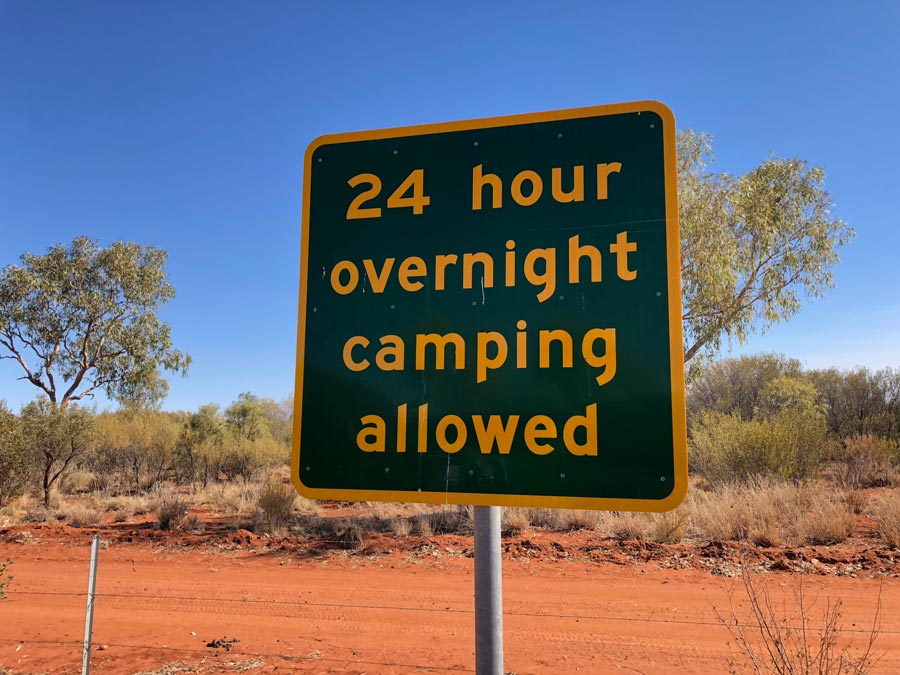
Where can I free camp in Australia?
Free and low cost camps in Australia are mainly found in Roadside Rest Areas, State Forests and Reserves and National Parks.
The easiest way to find these locations is to use an app like Wikicamps or Campermate and books like Camps Australia Wide and HEMA's Where To Camp Guide.


Check out this post for plenty more information about free camping your way around Australia > Free Camping Your Way Around Australia in 2022
Create your own power
One of the best ways to drive around Australia on a budget is to be able generate and store your own power.
This will help you to be self sufficient and give you the freedom to take advantage of free and low cost camps and give you the option to skip paid caravan parks.
Even when you do check in to a caravan park you'll find the cost of an unpowered site is generally much less than a powered site so just having the option to choose unpowered sites gives you more flexibility and opportunity to save money.
Small generators are available for well under $2000 and will give you power on demand but they do have a cost to run and there are restrictions on where you can use them due to the noise they make.
Most caravan parks and National Parks won't let you use generators.
Check out generators at MyGenerator.com.au
Tip: If you do take a generator, take a long extension cable (50m) so you can put the generator a long way from your camp.
Solar power and lithium batteries have evolved significantly in recent years and are now very efficient and relatively affordable.
While you might invest several thousand dollars in a good solar/battery setup, the independence you get and the savings on paying for powered sites could be multiple times that over your trip.


Whether you use a generator, a solar power setup or both, being able to create and store your own power is a key part of helping you to be able to free camp and save thousands on caravan park fees.
Pack Lunches For Driving Days
I lost count of the number of cheese and vegemite sandwiches we ate on our Big Lap because they are quick, easy and cheap.
By packing lunch and snacks in the morning before you leave (or the night before) you’ll be far less likely to roll into a roadhouse starving hungry and drop $50 or more on a pile of ‘less than ideal’ and very expensive fast food.
You’ll find that a cup of hot chips for $5.00 will satisfy the kids’ need for something greasy while the sandwiches and fruit you packed that morning do the heavy lifting.
Drinks from roadhouses and other service station/convenience stores are a wallet buster as well - it’s not unusual to pay $5.00 or more for a soft drink, juice or sports drink which adds up fast.
A flask of cordial or just plain water is much cheaper.
And if soft drinks are essential then buy them from the supermarket in bulk for a fraction of the price of cold ones from the fridge.
You can also give your kids a snack bag at the start of the day for them to graze on, similar to a school lunch box. This takes the edge of their appetite and will save you dollars at the roadhouse.
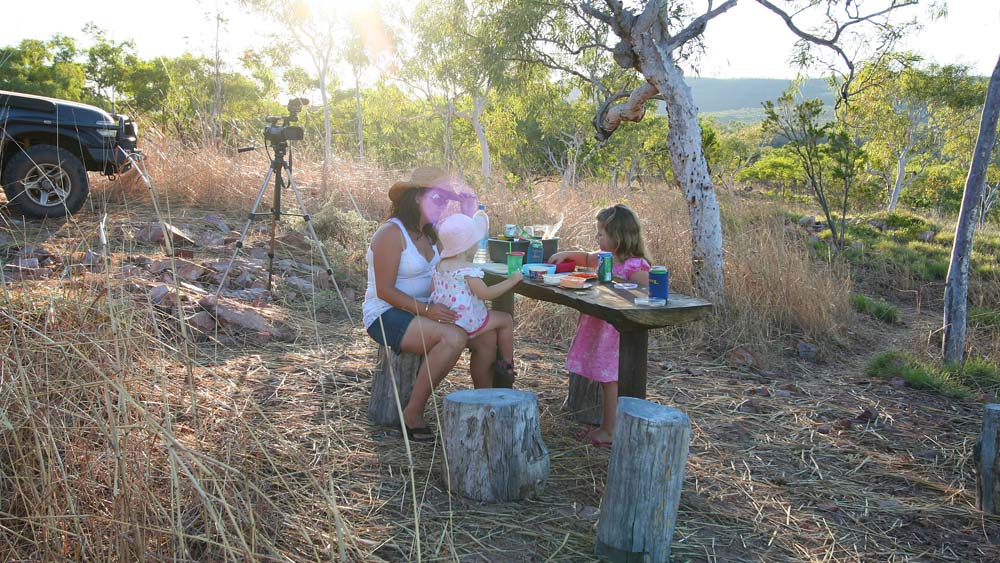
Have a kitchen setup that is easy to open at roadside stops
Take the packed lunch idea to another level by having a camp kitchen that's easy to open up and use at roadside stops.
This will make it much easier for you to avoid the temptation of stopping in to a road house or fast food outlet.
Whether you have a caravan, camper trailer or you are living out of your vehicle, there are many ways to setup a camp kitchen that can be available to use almost instantly.
A classic roadside lunch is wraps with cold meat and salad, boiled eggs, cheese, biscuits and fruit - it's quick, easy, healthy and cheap. Wraps travel a lot better than conventional bread and they usually come in zip lock packets these days which is even better.
We actually made the mistake of not having a kitchen built into our camper trailer when we started our Big Lap so I built one when we were in Broome and it served us well on many roadside lunch stops for the rest of the trip.
Once we had access to our stove at roadside lunch stops then making our own coffees and even cooking up a sausage sizzle was added to the lunch options.

Buy Local & Opportunistically
Buy local fruit & veggies in season and look for local sellers rather than supermarket chains.
For example . . .
In Kununurra they grow huge volumes of melons which are sent all over Australia and even into Asia.
The Coles supermarket in Kununurra was selling those big round basketball sized watermelons for $3.00kg.
I picked up one of the watermelons and put it on the scales and it weighed 9.5kg so it would have cost just under $30 . . . yes $30 for a watermelon which was grown 1km away.
No doubt it was shipped from the grower in Kununurra to the distribution centre in Sydney then back to Coles in Kununurra or something equally as crazy.
Down the road was a local fruit and veggies seller where you could buy the local produce for a fraction of the cost and in better condition.
Roadside fruit and veggie stands and local markets are great sources of local and great quality produce and you’ll have the time to stop and take a look.
Building on the theme of buying local, be on the lookout for opportunities to save a dollar or two.
When we were in Geraldton, Western Australia, a local came up to us in the caravan park with a couple of crayfish for sale. They catch a lot of crayfish off the coast at Geraldton and he worked in the local processing plant.
He told us that as staff they get to buy a couple every day very cheaply and he’d eaten enough crayfish to last a lifetime - so we managed to pick up a couple of beautiful crayfish for just $10.00 each.
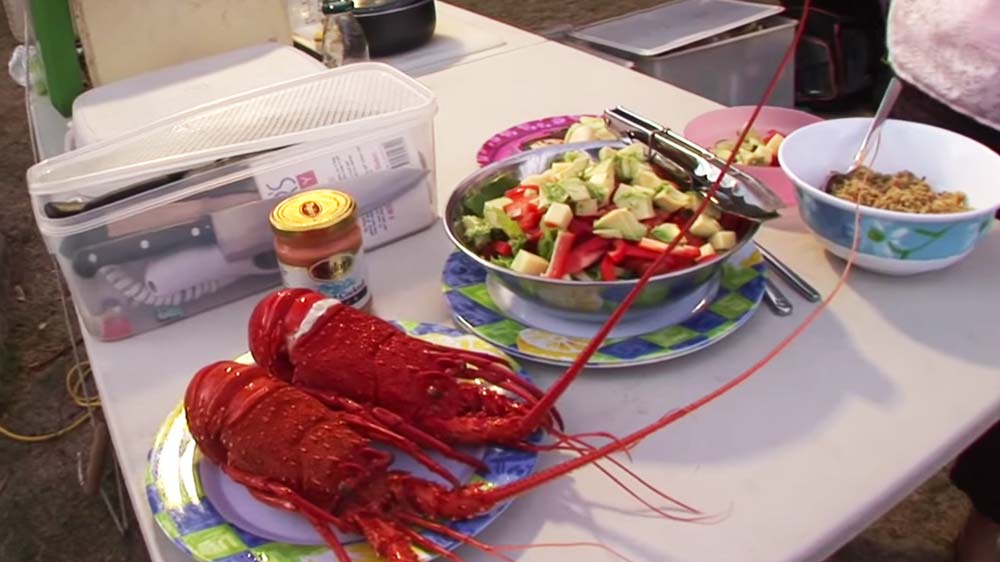
Take A Freezer
You’ll definitely be planning to take a fridge on your Big Lap but what about a freezer?
I’d actually rate having a freezer as more important than a fridge and if you have both then that’s ideal.
Before the introduction of dual zone fridges, it was common for travellers to run their fridge as a complete freezer and use freezer bricks in an esky or ice box to keep drinks and other perishables cool.
Then just rotate freezer bricks between the esky and freezer each day.
Frozen veggies have virtually the same nutritional value as fresh ones and are a better alternative than canned food which is often overcooked and heavy to lug around.
Likewise you can freeze beef mince, chicken fillets, steak, sausages, bacon etc which you can buy when you can get it cheap at large supermarkets or local sellers then use when you are in remote areas.
This way you’re still eating healthy decent food and not paying a ‘remote area tax’.

Share Meals When Eating Out
Let’s face it, you’re on holidays and sometimes the counter meal at the pub or dinner at the RSL is going to be too good to pass up.
It doesn’t have to be a wallet buster though with a bit of restraint.
Most pub and club meals these days are huge and often come with a higher price tag than they used to.
In order for the venue to charge more they need to give you a plate full of food so you feel like you’re getting good value.
We would often order one main meal and a couple of sides like chips, salad or garlic bread and share it between us. So for around $30 - $40 we’d all get dinner and feel satisfied.
Take a look around at the meals other people are eating and you’ll get an idea of how much to expect on your plate.
We’ve never encountered any venue that objected to us sharing one or two meals between us as I guess from their perspective it is better than nothing at all.
While most places have a kids menu, if they didn’t we’d ask them to split an adult meal like a pasta between the two kids which brings it back to about kids portion size and kids menu price.
Of course we’d never sit down and say ‘we’re on a tight budget’ . . . it would be more like ‘we’re not super hungry so we’ll just share a couple of dishes’.
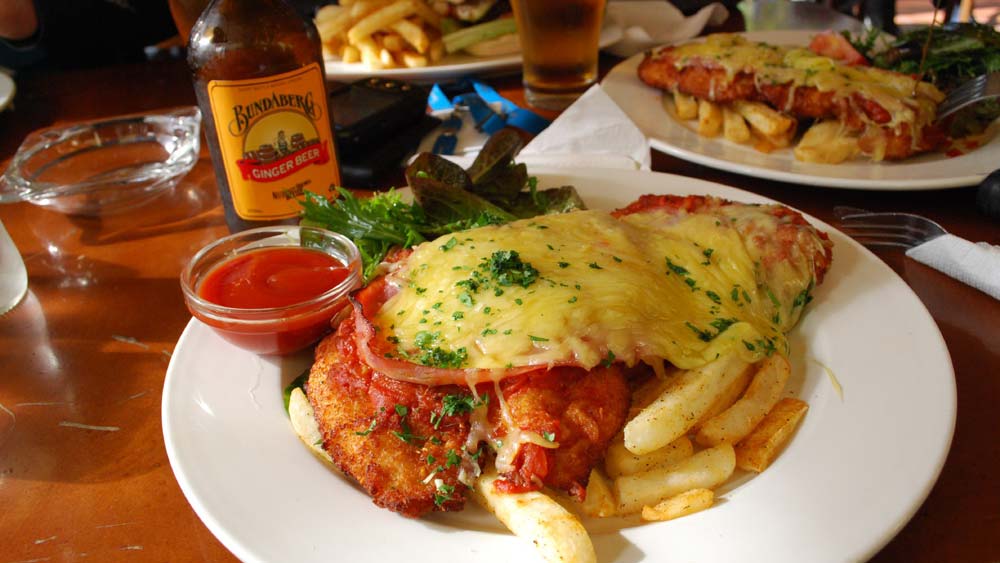
Buy Ice Creams from the Supermarket
Have you seen the price of ice creams in roadhouses and service stations lately?!?
4 ice creams could set you back $20 if you’re not careful.
So the better option is to drive past the service station to the supermarket and grab a box of ice creams from the freezer.
Both Coles and Woolworths have boxes of four imitation Magnums these days for $4.00 so only $1.00 each - and they are 95% as good as the real thing.
And much better on the back pocket!
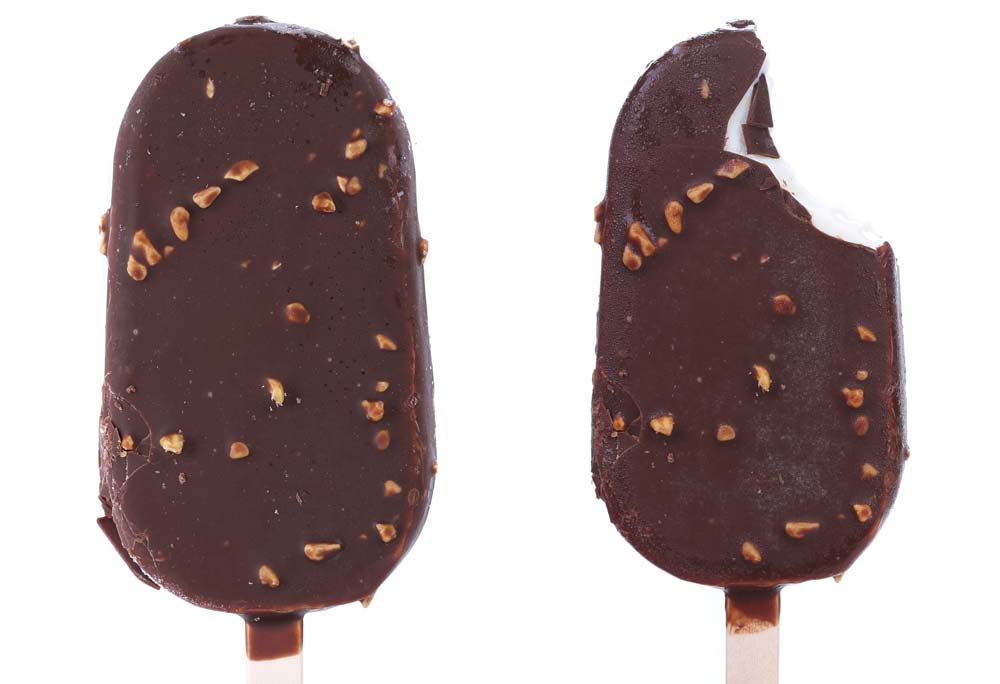
Embrace The Goon Bag (aka cask wine)
When I was a teenager and didn't have much money to spend of drinking, the humble 'goon bag' was often in play.
In case you don't know, 'goon bag' refers to cask wine and historically it was the domain of cheap and not so good wine that was sold in bulk at low prices.
But these days wine in casks has improved considerably and you can now get some quite good and very drinkable wine in 2 ltr casks for under $20 that are perfectly designed for the road trip lifestyle.
No heavy and breakable glass bottles, convenient box shape for easy storage and the box makes good tinder for your camp fire after it's finished.
Having a cask or two of your favourite drop on board for your Big Lap will not only add value to those sunsets and fireside chats but also save you a lot of money buying drinks at bar prices.
Conclusion
While it is definitely possible to drop $200k on a shiny new 4WD and caravan and then spend $2k or more per week driving around the country, there is absolutely no need to go down this path.
Nor should you feel any pressure to do so.
When you get out on the road you realise that the material things that are so important at home are much less so when you are travelling, and in fact the less stuff and complication you have to deal with, the more free you are.
I believe the Dalai Lama once said that 'Possessions are a burden you carry through life'.
This is never more true than when your worldly possessions are in the vehicle and van you are living in.
Make that burden as light as possible and you'll not only be able to drive around Australia on a budget but you'll have a better trip as well.

